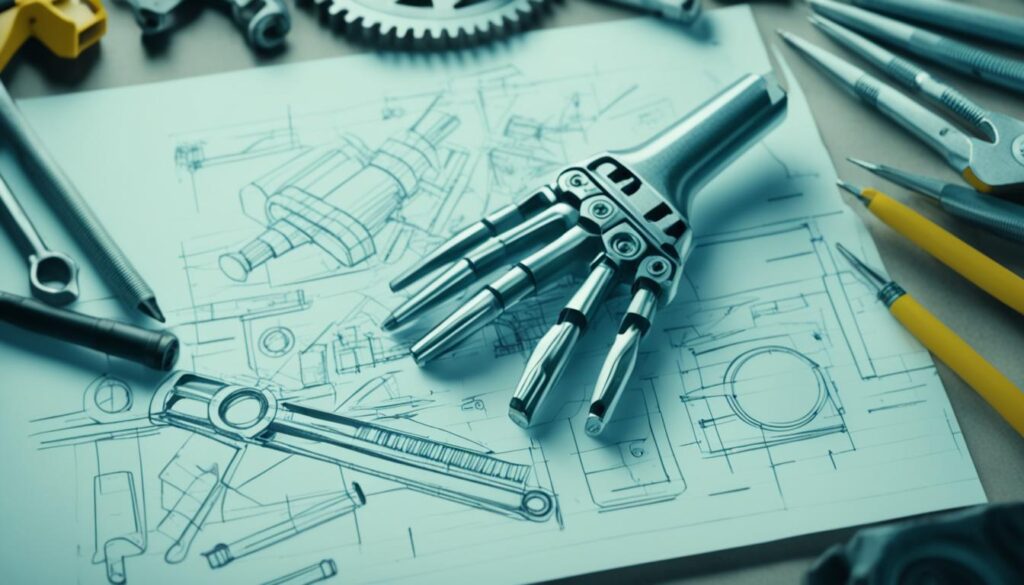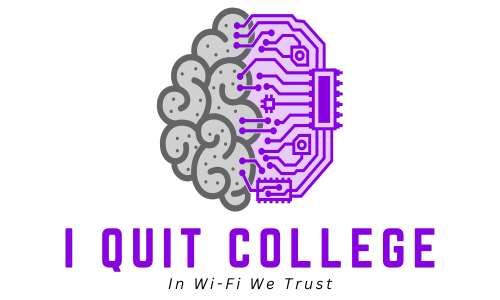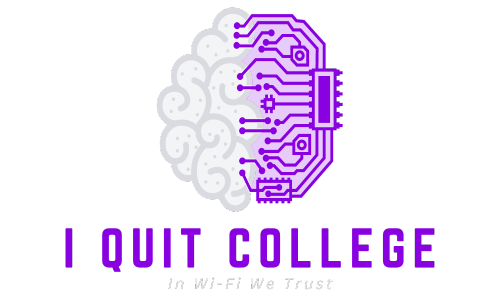Product development is an exciting journey that takes an idea and transforms it into a tangible reality. Whether you are a startup looking to launch a new product or an established company seeking product innovation, understanding the product development process is vital for success.
At its core, product development encompasses various stages, from conceptualizing and designing to prototyping and launching. Each step plays a crucial role in transforming your idea into a marketable product that meets customer needs and stands out in a competitive landscape.
In this article, we will explore the key aspects of product development, including the importance of prototypes, the purpose they serve, and the phases involved in their development. By delving into the intricacies of this process, you can gain valuable insights and navigate the product development journey with confidence.
Key Takeaways:
- Product development is the process of turning an idea into a marketable product.
- Prototypes play a crucial role in product development by allowing you to test functionality and make necessary revisions.
- The purpose of a prototype is to validate the product idea and ensure it meets customer expectations.
- The prototype development process consists of phases such as feasibility analysis, detailed design, and manufacturing preparation.
- By following best practices and collaborating with experienced product development firms, you can increase your chances of success.
What Is Prototype Product Development?
Prototype product development plays a pivotal role in the overall product development process. It involves creating a physical model of the product to test its functionality and desirability. Through the use of prototypes, developers can visualize the product and make necessary revisions before moving forward with mass production. This iterative process involves multiple revisions based on thorough research, testing, and valuable feedback. Prototypes provide crucial information about the dimensions, design, and overall functionality of the final product.
Prototyping allows developers to have a tangible proof of concept. It enables them to fine-tune the product design, ensuring that it meets customer needs and expectations. By identifying potential flaws and areas for improvement, prototype testing helps refine the product, making it more market-ready.
During the prototype product development stage, developers use various testing methodologies to assess the product’s viability. By gathering data and insights, they can make informed decisions to enhance the product’s performance, address any design flaws, and optimize its overall user experience. It is through this rigorous testing phase that the product’s strengths and weaknesses can be identified, allowing for further iterations and improvements.
Benefits of Prototype Product Development
Prototype product development brings several advantages to the overall product development process:
- Allows for proof of concept: Prototypes provide tangible evidence of the product’s feasibility and potential success in the market.
- Enables early feedback and iteration: By gathering feedback during the prototyping phase, developers can iterate and refine the product design to meet customer expectations.
- Reduces development costs: Identifying and addressing design flaws or functionality issues at the prototype stage can save significant costs in the long run, preventing expensive reworks during mass production.
- Aids in communication: Physical prototypes provide a clear visual representation of the product, facilitating effective communication with stakeholders, investors, and potential customers.
By investing time and resources in prototype product development, companies can increase their chances of creating a successful, market-ready product. It allows them to validate the product idea, fine-tune the design, and address any potential issues before proceeding to full-scale production.

The Purpose of a Prototype
In the product development process, building a prototype serves a primary purpose: to validate the product idea and test its functionality. Prototypes play a crucial role in ensuring that the product effectively solves a consumer problem and performs as intended. With a prototype in hand, developers can gather valuable feedback and iterate on their design until it meets all the necessary criteria.
A key advantage of using prototypes is the ability to test the functionality of the product in a tangible form. By physically interacting with the prototype, developers can identify any flaws or usability issues early on and make the necessary improvements. Functionality testing helps to refine the product, ensuring that it delivers the expected user experience.
Moreover, prototypes provide an opportunity for iteration. Developers can gather feedback from potential users, stakeholders, and experts to gain insights into the product’s strengths and weaknesses. This iterative process allows for continuous refinement, resulting in a more polished and successful final product.
Additionally, prototypes play an essential role in manufacturing preparation. They provide manufacturers with detailed design specifications that guide them in producing the product at scale. This ensures that the final product aligns with the intended design and meets all quality standards.
Overall, the purpose of a prototype goes beyond simply creating a physical model. It serves as a tool for product validation, functionality testing, iteration, and manufacturing preparation, enabling developers to refine their product and increase its chances of success.

Quotes:
“Prototypes are invaluable for gathering user feedback early in the development process. They allow us to identify and address potential issues before investing significant resources in mass production.” – Sarah Johnson, Product Designer
Benefits of Prototyping:
- Validates the product idea
- Tests functionality
- Identifies design flaws and usability issues
- Refines the product through iteration
- Provides manufacturing specifications
| Benefits of Prototyping: | Functions |
|---|---|
| Validates the product idea | Ensures the product solves a consumer problem and meets market needs |
| Tests functionality | Evaluates how the product performs and functions |
| Identifies design flaws and usability issues | Helps refine the design and user experience |
| Refines the product through iteration | Allows for continuous improvement based on user feedback |
| Provides manufacturing specifications | Guides manufacturers in producing the product as intended |
The Prototype Development Phases
The prototype development process consists of several phases that are crucial to the success of a product. Each phase involves different activities and requires careful planning and collaboration to ensure a smooth and efficient product development process.
Phase 1: Definition and Feasibility Analysis
In this phase, the product idea is defined, and a feasibility analysis is conducted to determine its market viability. Extensive research is performed to gain insights into customer needs, market trends, and competitors. This research helps in evaluating the technical, economic, and commercial feasibility of the product.
During this phase, key questions are addressed, such as:
- Is there a demand for the product in the market?
- What are the potential challenges and risks associated with developing the product?
- What resources and expertise are required to bring the product to market?
The outcome of this phase is a clear understanding of the product’s feasibility and the green light to proceed to the next phase.
Phase 2: Detailed Design
Once the feasibility of the product is confirmed, the focus shifts to detailed designs based on the initial product drawings and user requirements. This phase involves creating technical specifications, engineering drawings, and detailed product architecture.
The design team collaborates closely with stakeholders to ensure that the product design aligns with the market needs and meets the desired functionality. Iterative design processes, such as rapid prototyping, are commonly used to refine the design and incorporate feedback from users and stakeholders.
Phase 3: Prototyping and Iteration
In this phase, prototypes are created to test and validate the design. Prototyping allows developers to identify potential flaws and make necessary refinements before proceeding to mass production.
The prototype undergoes rigorous testing to ensure that all functional and aesthetic requirements are met. Through iterations and feedback, the prototype is refined and optimized to deliver the best possible user experience.
Phase 4: Final Design and Manufacturing Preparation
Once the prototype is refined and approved, the final design phase begins. The product is prepared for manufacturing by creating detailed specifications that include materials, dimensions, and manufacturing processes.
This phase requires close collaboration between the design team and manufacturing partners to ensure a seamless transition from prototype to mass production. Any necessary adjustments are made to ensure that the design is suitable for large-scale manufacturing, while maintaining the desired product quality.
By the end of this phase, the product is ready to move into the production stage, leading to its eventual launch in the market.
Throughout the prototype development process, feasibility analysis, research, design refinement, and manufacturing preparation are critical components for successfully bringing a product from concept to reality.
Conclusion
The product development process is a complex and intricate journey that requires careful planning, extensive research, and iterative design. By adhering to best practices and understanding the different stages of product development, you can significantly enhance your chances of achieving success.
One of the key success factors in the product development process is conducting thorough market research. By gaining a deep understanding of customer needs, preferences, and market trends, you can ensure that your product meets the demands of your target audience. Additionally, validating your product idea through market research helps in minimizing potential risks and increasing the likelihood of market acceptance.
Another crucial aspect of the product development process is testing the functionality of your product through prototypes. Prototypes allow you to refine and improve the design, ensuring that the final product performs as intended. Through iterative testing and feedback, you can identify any flaws or areas for improvement, ultimately resulting in a high-quality and desirable product.
Collaboration with experienced product development firms can significantly contribute to the success of your product. These firms provide valuable expertise, industry insights, and resources that can help streamline the product development process. Their guidance and support can aid in avoiding common pitfalls and maximizing the potential of your product.
By embracing the product development process, following best practices, and leveraging the expertise of product development firms, you can navigate the complexities of bringing your idea to life. With careful planning, diligent research, and a commitment to iterative design, you can transform your concept into a successful and market-ready product.






